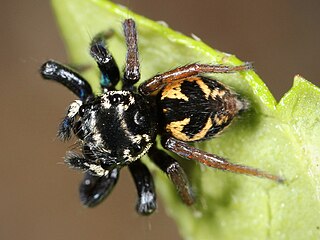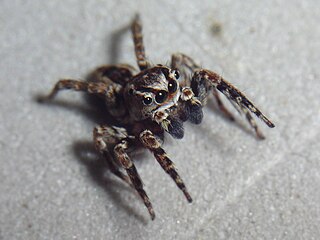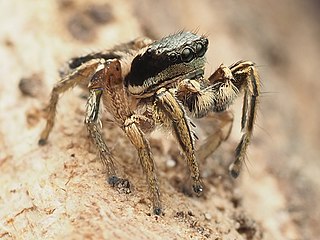
Habronattus is a genus in the family Salticidae. Most species are native to North America. They are commonly referred to as paradise spiders due to their colorful courtship ornaments and complex dances, similar to birds-of-paradise.

Balmaceda is a genus of jumping spiders that was first described by George Peckham & Elizabeth Peckham in 1894.

Beata is a genus of jumping spiders that was first described by George Peckham & Elizabeth Peckham in 1895.

Chapoda is a genus of jumping spiders that was first described by George Peckham & Elizabeth Peckham in 1896.

Corythalia is a genus of jumping spiders that was first described by Carl Ludwig Koch in 1850. The genus is distributed throughout most of the Western Hemisphere. Species of this genus are found in The Americas.

Freya is a genus of jumping spiders that was first described by Carl Ludwig Koch in 1850. The name is derived from Freya, the fertility goddess of Norse mythology.

Lyssomanes is a spider genus of the family Salticidae, ranging from South and Central America, up to the southern United States.

Metaphidippus is a genus of jumping spiders that was first described by Frederick Octavius Pickard-Cambridge in 1901. The name is combined from Ancient Greek μετά "after, beside" and the salticid genus Phidippus.

Mexigonus is a genus of North American jumping spiders that was first described by G. B. Edwards in 2003. The name is a reference Mexico, where the first identified species were found.

Pachomius is a genus of jumping spiders that was first described by George and Elizabeth Peckham in 1896. Uspachia was merged into genus Romitia in 2007, and all nine species were merged into Pachomius in 2015. The name is derived from Pachomius, the founder of cenobitic monasticism.

Paramarpissa is a genus of North American jumping spiders that was first described by Frederick Octavius Pickard-Cambridge in 1901. Originally considered a synonym of Pseudicius, it was separated into its own genus in 1999.

Paraphidippus is a genus of jumping spiders that was first described by Frederick Octavius Pickard-Cambridge in 1901. The name is a combination of the Ancient Greek "para" (παρά), meaning "alongside", and the salticid genus Phidippus.

Phanias is a genus of jumping spiders that was first described by Frederick Octavius Pickard-Cambridge in 1901. They are similar to members of Marpissa, but have three pairs of spines beneath the first tibia.
Sidusa is a genus of jumping spiders that was first described by George and Elizabeth Peckham in 1895.

Synemosyna is a genus of ant mimicking jumping spiders that was first described by Nicholas Marcellus Hentz in 1846.

Micrathena, known as spiny orbweavers, is a genus of orb-weaver spiders first described by Carl Jakob Sundevall in 1833. Micrathena contains more than a hundred species, most of them Neotropical woodland-dwelling species. The name is derived from the Greek "micro", meaning "small", and the goddess Athena.

Metepeira is a genus of orb-weaver spiders first described by F. O. Pickard-Cambridge in 1903. The name is derived from the Ancient Greek μετά and the obsolete genus name Epeira, denoting a genus similar to Epeira.

Metacyrba taeniola is a species of spider in the family Salticidae, the jumping spiders. Males grow to a length of 4.4–6.0 millimeters (0.17–0.24 in), while females reach 5.0–7.2 mm (0.20–0.28 in). M. taeniola differs from related species such as Metacyrba floridana and M. punctata by its greater overall size, and by the relative broadness of its carapace, which is around 70% of the length of the carapace.

Elaver is a genus of sac spiders first described by Octavius Pickard-Cambridge in 1898.

Habronattus mexicanus is a species of jumping spider in the genus Habronattus. The species was first identified in 1896 in Mexico, after which it is named, originally allocated to the genus Habrocestum. The species has subsequently been identified in locations in North and Central America, as well as islands in the Caribbean Sea. The spider is small, but displays one of the most complex sexual displays, including sophisticated vibatory song patterns.



















